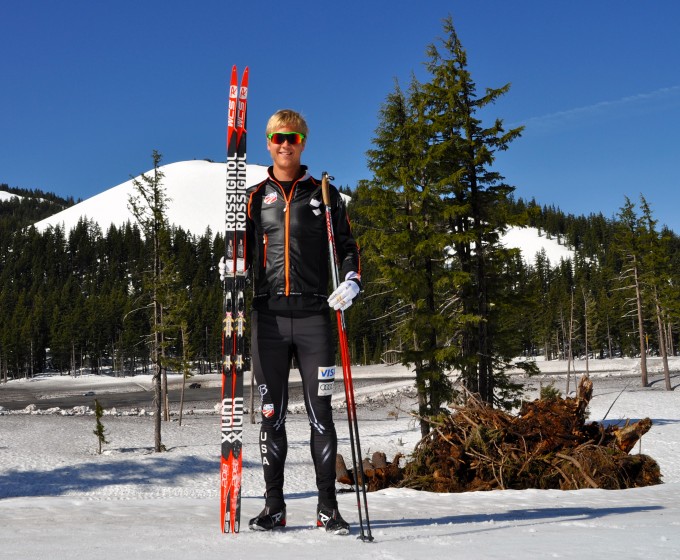
When the U.S. Ski Team rolled into Bend, Ore., for their annual spring training camp in May it felt like home. With outstanding support from Mount Bachelor and its staff, excellent conditions, and a welcoming community, the team and their coaches were more than comfortable in what many would call the contiguous United States’ spring-skiing mecca.
Despite the usual volatility of the weather in Bend, the 2014 camp held only one day of significant snowfall for the team which included 2014 Overall World Cup Sprint Champion Kikkan Randall, 2014 Olympic standout Sophie Caldwell, and veteran Andy Newell.
According to U.S. Ski Team (USST) Women’s Coach Matt Whitcomb, the conditions were the best that the team had seen in four to five years. The crust cycle this past May, which had been unfavorable in the past, allowed the team to complete the tradition an over-distance ski in the Broken Top meadows on the camp’s last day.
“That workout alone is reason enough to cross country ski,” said Whitcomb of their workout in an email. “If you can ski well enough to get up there safely, it’s just something you need to do. That’s a direct order.”

The Bend camp served as fresh start for the U.S. Ski Team as it begins its quest for even stronger results in the 2014-2015 season. However, that doesn’t mean the camp consisted of nonstop intensity and endless over-distance skis. Rather, it was an opportunity to regroup and establish plans for the coming year. As part of this strategy, USST Head Coach Chris Grover, articulated his plan for each athlete and asks for feedback in return so that all parties are on the same page.
The Bend camp also served as an opportunity for team building. While it’s hard to imagine the U.S. Ski Team getting any closer than they already are, the Bend camp cemented their bonds as both the women’s and men’s team developed team goals that involve training, racing, and community involvement.
The actual training in the 2014 camp was comprised of less intensity this year, and focused on bolstering technique early on in the season. Using a visualization practices involving video, U.S. Ski Team coaches aided athletes in their technical skiing.
“It’s a new quadrennial and we want to enter the World Cup season having the most technically improved team. We ski well but can do better,” said Whitcomb.
In order to enter their new era of technical advancement, the U.S. ski team coaches reviewed every World Cup race from the 2013-2014 season. They then converted these races into accessible clips that featured foreign competition so that the year’s evolutions in technique could be studied. These clips were then used for specific workouts so athletes could visualize the technique they were working towards. An example of a visualization workout involving striding can be found in this week’s Wednesday Workout.

According to Whitcomb, athletes found the visualization practice productive as well as challenging, especially once it was applied on snow. However, the exercise involved some amusement as well.
“I think the team had some fun with it,” said Whitcomb. “Some of the drills included skipping on skis in classic tracks, downhill striding, one ski slalom followed by a 2-ski GS course, and various cornering exercises to improve comfort while skiing on the outside edge of the ski.”
Despite the camp’s success, the Bend also brought some challenges to the team. These troubles came in the form of injury to both Sophie Caldwell and Erik Bjornsen.
“It’s definitely a bummer to have couple injuries during a camp,” said Whitcomb. “It’s tough for everyone because Erik and Sophie are such great personalities to have at training. In elite sport we do our best to push the physical envelope in smart, creative ways to gain fitness while trying to remain injury free. Sometimes it isn’t enough. It can be that we pushed too hard, and it can sometimes be a matter of chance.”
According to Bjornsen’s support staff in Alaska, he irritated his L3/4 disc during a double pole interval session as a result other discs being so tight.
“A strong guy like Erik can put down a lot of force and he got unlucky,” Whitcomb said. Despite his injury, Bjornsen is predicted to return to training in a matter of weeks.
Caldwell’s status, on the other hand, is still up in the air. After a mountain-bike tumble in Bend, the rising star fractured her elbow. While remaining upbeat, she has begun a training regimen that isolates her legs and protects her arm with activities such as skating without poles, hiking, and spinning.

After her second MRI in Park City, Utah, on June 2, specialists had yet to give a full prognosis. According to Whitcomb, there is a possibility that Caldwell’s radius may have been injured in addition to the humorous. There is also a chance that several floating bone flecks may not absorb naturally, thus requiring surgery to remove them.
While injuries are always unwanted, Whitcomb stressed that sometimes it is impossible to avoid injury while training 800-plus hours a year. In the wake of Caldwell’s accident, he believes mountain biking can be useful for training.
“Mountain biking will always be a risk, but we’re also aware it is fun and has some important application to what we do,” he said. “We try to add things like swimming and biking that are low impact and allow for more volume. I suspect it’s something we’ll continue to do for those that like to bike, but at the moment we’re kicking ourselves.”
Injuries aside, the U.S. Ski Team will continue their work towards improved technique, speed, and strength throughout the summer months. Their next summer training camp will take place Alaska next month.
Lander Karath
Lander Karath is FasterSkier's Associate Editor from Bozeman, Montana and a Bridger Ski Foundation alumnus. Between his studies at Middlebury College in Vermont, he is an outdoor enthusiast and a political junkie.



